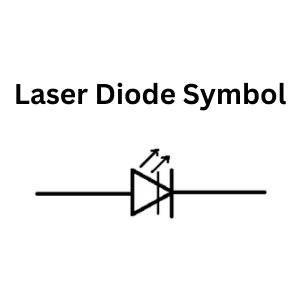Laser Diode
Table of Contents
ToggleWhat is Laser Diode?
A laser diode is a compact semiconductor device that emits coherent and highly focused light when electricity passes through it. It operates on the principle of stimulated emission, where electrons, when excited by the current, release photons that trigger more photon emission, resulting in a concentrated beam of light. Laser diodes are widely used in applications such as telecommunications, optical storage, laser printing, barcode scanning, medical instruments, and scientific research. They offer efficiency, wavelength versatility, and modulation capabilities, making them essential for various tasks that require precise and powerful laser light in a compact form factor.
Laser Diode Symbol

Working Principle of Laser Diode
A laser diode operates on the principle of stimulated emission within a semiconductor material. When an electric current is applied to the diode, it creates a population inversion, meaning more electrons occupy higher energy levels than lower ones. As these excited electrons return to lower energy states, they emit photons. Some of these photons stimulate nearby excited electrons to emit additional photons, creating a cascade effect. These emitted photons have the same frequency, phase, and direction, resulting in coherent and highly focused laser light. A partially reflecting mirror at one end of the diode cavity allows this light to build up and exit as a concentrated laser beam.
Characteristics of Laser Diode
Laser diodes have several important characteristics that make them unique and well-suited for various applications:
-
Coherence: Laser diodes produce coherent light, where all the photons have the same frequency and phase. This coherence allows for a tightly focused and narrow beam of light.
-
Monochromaticity: Laser diodes emit light at a specific, well-defined wavelength (color), making them useful for applications requiring precise wavelengths, such as optical communications or medical procedures.
-
Directionality: Laser diodes generate a highly directional beam of light, which is beneficial for tasks like precision cutting, targeting, and long-distance optical communication.
-
Efficiency: Laser diodes are energy-efficient, converting a significant portion of electrical energy into laser light. Its efficiency reduces power consumption and heat generation.
-
Compact Size: Laser diodes are small and lightweight, making them suitable for integration into various devices and systems.
-
Fast Modulation: Laser diodes can be modulated at high frequencies, enabling rapid on-off switching for applications like data transmission and laser printing.
-
Long Lifespan: When operated within their specified parameters, laser diodes can have a relatively long operational lifespan.
-
Variable Wavelengths: Different materials and structures can produce laser diodes with varying wavelengths, enabling their use across a broad spectrum of applications.
-
High Power Output: Laser diodes can emit high-power laser beams, making them suitable for tasks like material processing and laser engraving.
-
Solid-State Reliability: Laser diodes are solid-state devices, meaning they have no moving parts, which increases their reliability and durability.
-
Temperature Sensitivity: Laser diodes can be sensitive to temperature changes, so thermal management is often necessary to maintain their performance.
-
Spectral Line Width: Laser diodes typically have a narrow spectral line width, which is important for applications requiring precise spectral characteristics.
These characteristics make laser diodes indispensable in various fields, including telecommunications, medical devices, scientific research, industrial manufacturing, and consumer electronics.
Applications of Laser Diode
Laser diodes find applications in a wide range of fields due to their unique characteristics, including coherence, monochromaticity, and directionality. Here are some common applications of laser diodes:
Telecommunications: Laser diodes are crucial in optical fiber communication systems for transmitting data over long distances. They provide high-speed and high-bandwidth communication channels.
Laser Printing: Laser diodes are used in laser printers and photocopiers to create high-quality text and images with precision.
Optical Storage: Laser diodes are key components in CD, DVD, and Blu-ray players for reading and writing data on optical discs.
Medical and Dental: Laser diodes are used in various medical applications, including laser surgery, dermatology, dental procedures, and optical coherence tomography (OCT) for imaging tissues.
Barcode Scanners: Laser diodes are employed in barcode scanners for rapid and accurate data capture in retail and logistics.
Laser Pointers: Compact laser diodes are used in handheld laser pointers for presentations, astronomy, and educational purposes.
Material Processing: High-power laser diodes are utilized in material processing applications such as cutting, welding, engraving, and heat treatment.
LIDAR (Light Detection and Ranging): Laser diodes are used in LIDAR systems for remote sensing, environmental monitoring, and autonomous vehicles.
Spectroscopy: Laser diodes are employed in various spectroscopic techniques for analyzing the composition of materials and gases in fields like chemistry and environmental science.
Scientific Research: Laser diodes are used in laboratory experiments and research for applications such as laser cooling, trapping atoms, and generating specific wavelengths for experimental setups.
Fiber Optic Sensors: Laser diodes are used in fiber optic sensors for measuring parameters like temperature, pressure, and strain in industrial and environmental monitoring.
Surveying and Geodesy: Laser diodes are used in instruments like laser rangefinders and total stations for accurate measurements in surveying and geodetic applications.
Entertainment and Light Shows: Laser diodes are used to create captivating laser light shows in entertainment events and concerts.
Aerospace and Defense: Laser diodes are used in military applications for target designation, rangefinding, and communications.
Biotechnology: Laser diodes are employed in biotechnology for flow cytometry, DNA sequencing, and other diagnostic and analytical techniques.
Display Technology: Laser diodes are used in emerging display technologies, such as laser projectors and laser TVs, for improved color accuracy and brightness.
Gas Sensing: Tunable diode laser absorption spectroscopy (TDLAS) employs laser diodes to detect trace gas concentrations, making it useful in environmental monitoring and industrial safety.
Laser Diode in Optical Fiber Communication
Laser diodes are fundamental components in optical fiber communication systems. They emit high-intensity, coherent light at specific wavelengths used to transmit data over optical fibers. Laser diodes enable the encoding of digital information onto light signals, offering high bandwidth and low signal loss over long distances. The coherent nature of laser light allows for efficient multiplexing of multiple data channels, increasing transmission capacity. In telecommunications, laser diodes serve as transmitters in optical transceivers, enabling high-speed internet, voice, and video transmission. They play a critical role in modern networks, supporting the rapid and reliable exchange of data essential for our interconnected world.
Advantages and disadvantages Laser Diode.
Laser diodes, also known as semiconductor lasers, are optoelectronic devices that emit coherent light when current is passed through them. They have a wide range of applications, and they come with their own set of advantages and disadvantages:
Advantages of Laser Diode:
Coherent Light Emission: Laser diodes produce coherent light, which means that the light waves are in phase and have a well-defined wavelength. This property is essential for applications such as optical communication, precision measurements, and laser surgery.
Small Size and Compact Design: Laser diodes are small and compact, making them suitable for miniaturized and portable devices. This is particularly advantageous in applications such as laser pointers, barcode scanners, and optical data storage.
Efficiency: Laser diodes are energy-efficient devices, converting a relatively high percentage of electrical power into laser light. This efficiency is important in battery-powered or energy-sensitive applications.
Direct Modulation: Laser diodes can be directly modulated at high speeds, making them ideal for applications like optical fiber communication, data transmission, and laser printing.
Diverse Wavelengths: Laser diodes are available in a wide range of wavelengths, from ultraviolet to infrared, making them versatile for different applications in fields like telecommunications, medical treatments, and materials processing.
Long Lifespan: When operated within their specified parameters, laser diodes can have a long operational lifespan, providing reliable performance over time.
Disadvantages of Laser Diode:
Sensitivity to Environmental Factors: Laser diodes are sensitive to environmental factors like temperature and humidity. Variations in these conditions can affect their performance, stability, and wavelength output.
Risk of Eye and Skin Damage: Some laser diodes emit high-intensity beams that can be harmful to the human eye and skin. Adequate safety measures and precautions are necessary when working with high-powered laser diodes.
Cost: High-quality laser diodes, especially those designed for specific wavelengths or high power, can be expensive. This cost can be a limiting factor in some applications.
Alignment Challenges: Precise alignment of the laser diode and associated optical components is critical in many applications, making their integration and maintenance more challenging.
Limited Power Handling Capacity: Laser diodes are generally not suited for high-power applications due to their limited power handling capacity. High-power lasers typically use other types of lasers, such as solid-state or gas lasers.
Divergence: Laser diodes often exhibit poor beam divergence characteristics, which can limit their utility in applications where a well-focused beam is required.
In summary, laser diodes are valuable components with advantages such as coherent light emission, compact size, efficiency, and versatility in terms of wavelengths. However, they also come with challenges related to sensitivity to environmental factors, safety concerns, cost, and limitations in power handling and beam quality. The choice to use a laser diode in a specific application should consider these advantages and disadvantages.
Difference Between Led and Laser Diode
Laser diodes (LDs) and Light Emitting Diodes (LEDs) are both semiconductor devices that emit light, but they differ in several key ways:
-
Emission Type:
- Laser Diode (LD): LDs emit coherent, monochromatic light with a narrow spectral linewidth. The emitted light is highly directional and focused, resulting in a well-defined beam.
- Light Emitting Diode (LED): LEDs emit incoherent, non-monochromatic light. The light emitted by an LED covers a broader spectrum of colors and lacks the coherence of a laser.
-
Light Characteristics:
- Laser Diode: LDs produce intense, high-contrast light, suitable for applications requiring precision and focused beams, such as optical communications and material processing.
- LED: LEDs produce diffuse and less intense light, making them suitable for applications like general illumination, indicator lights, and displays.
-
Spectral Characteristics:
- Laser Diode: LDs emit light at a specific, well-defined wavelength (color), making them useful in applications requiring precise spectral characteristics.
- LED: LEDs emit a broader spectrum of colors, and their output is determined by the materials used in their construction.
-
Directionality:
- Laser Diode: LDs emit highly directional light, allowing for efficient coupling into optical fibers or the creation of a well-focused beam.
- LED: LEDs emit light in a more divergent pattern, making them less suitable for long-distance optical communication without additional optics.
-
Applications:
- Laser Diode: LDs are commonly used in applications requiring coherent and focused light, such as optical communication, laser printing, medical procedures, and material processing.
- LED: LEDs find applications in general lighting, display technology (e.g., LED screens and indicators), remote controls, and optical sensors.
-
Efficiency and Power:
- Laser Diode: LDs are typically more efficient at converting electrical energy into light and can emit higher power laser beams.
- LED: LEDs are energy-efficient but produce lower-intensity light compared to LDs.
-
Cost and Complexity:
- Laser Diode: Laser diodes tend to be more complex to manufacture and are often more expensive than LEDs.
- LED: LEDs are simpler and less expensive to produce, making them cost-effective for various applications.
In summary, the main distinction between laser diodes and light-emitting diodes lies in the coherence, directionality, and spectral characteristics of the emitted light. LDs produce focused, coherent light at a specific wavelength, while LEDs emit incoherent, less directional light across a broader spectrum.

